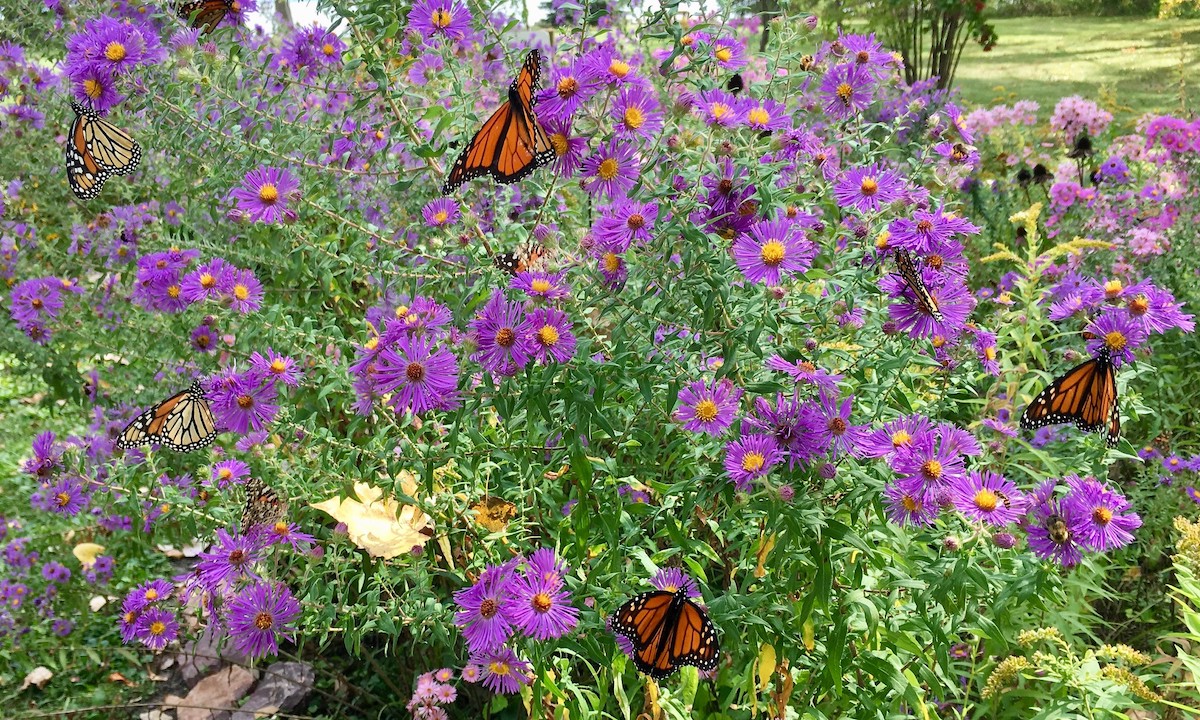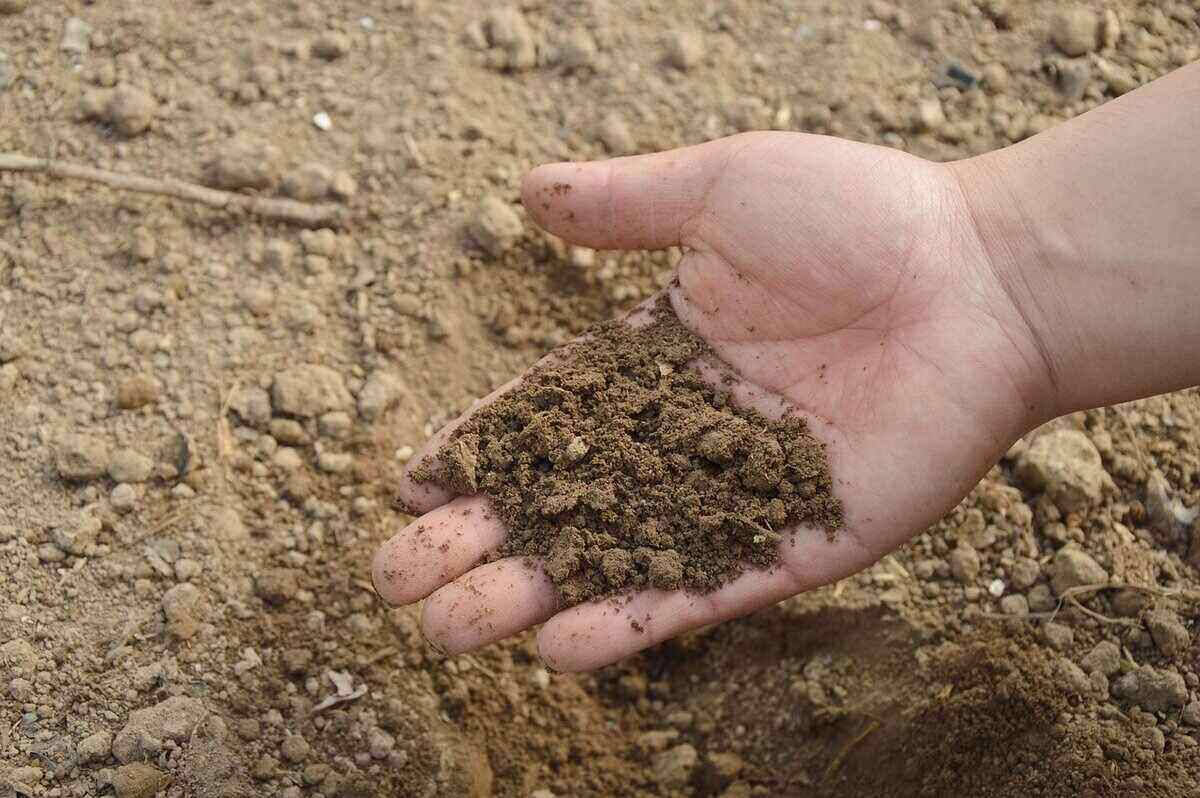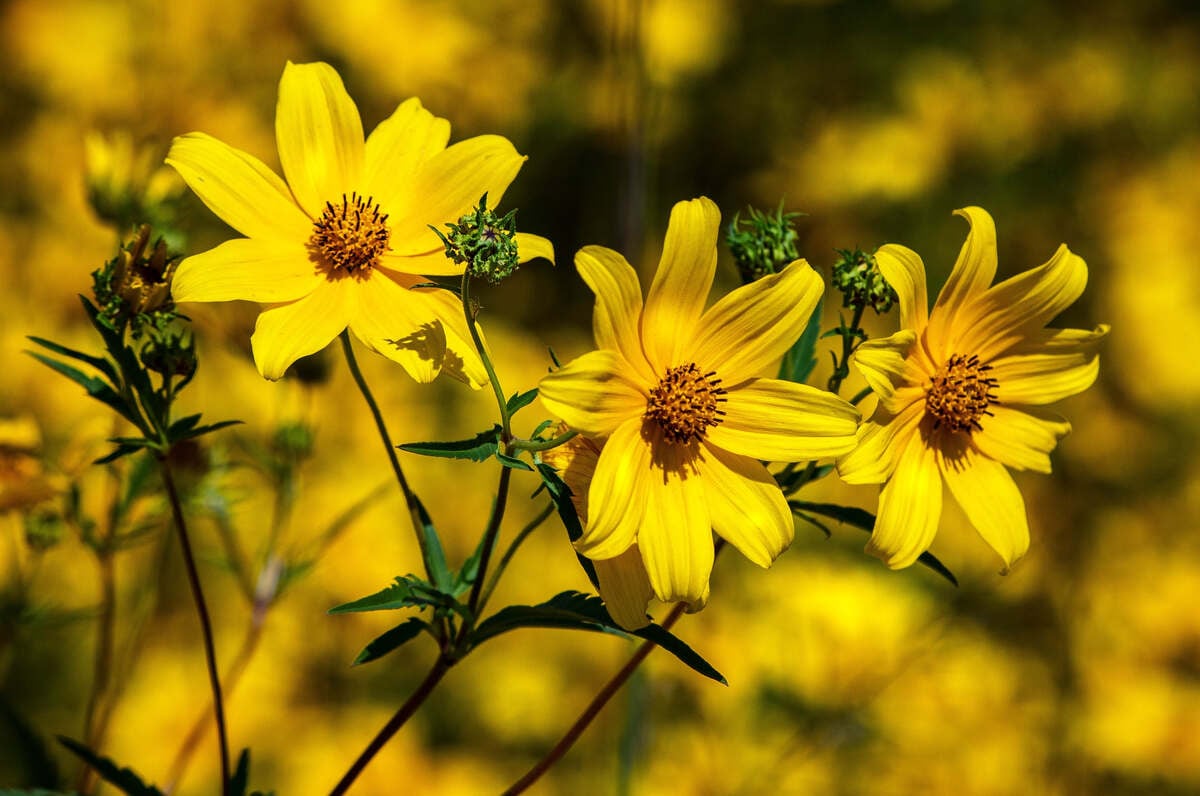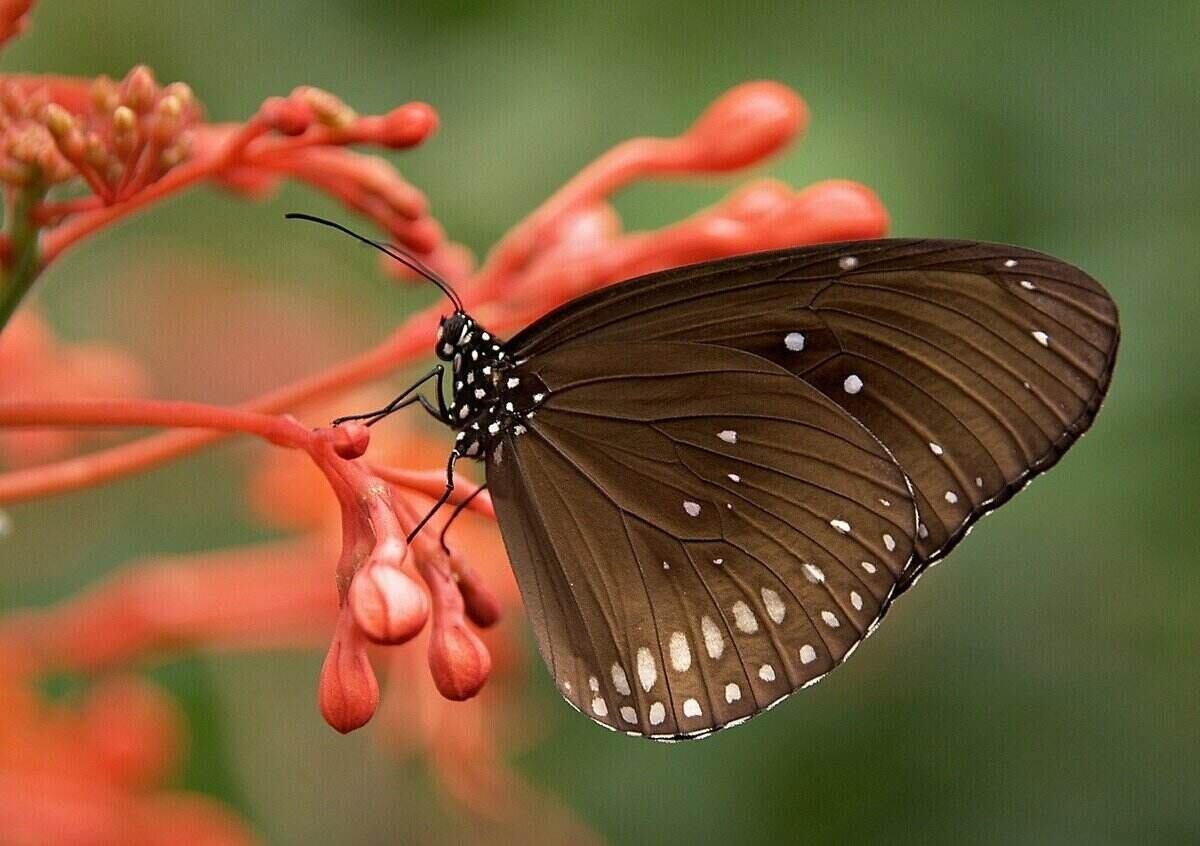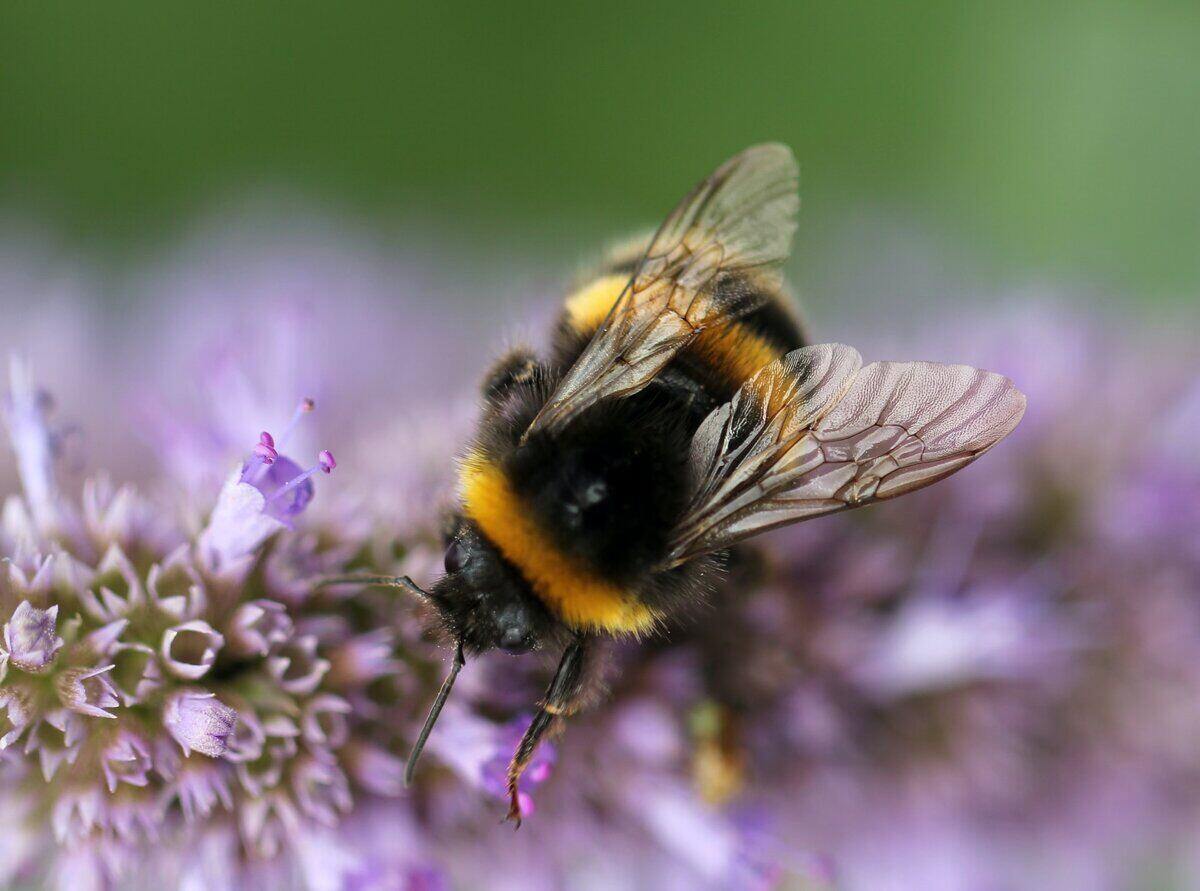
You want your pollinator garden to be inviting for winged wildlife and not a lot of work for you. These 10 best native plants for your pollinator garden will serve up nectar for the butterflies, hummingbirds, and honeybees and a riot of color and fragrances for you.
Native plant species are well-suited to your region’s climate and soil, and consequently, they’re low-maintenance. With some, you’ll just need to add water — but not too much. Most importantly, pollinators love native species despite the allure of international transplants like the butterfly bush.
The 10 pollinator-friendly plants we bring here are native across North America, which makes them great for the ecosystem and perfectly primed to support pollinators and attract beneficial insects to your yard.
- 1. Milkweed (Asclepias)
- 2. Wild Bergamot (Monarda fistulosa)
- 3. Snapdragons (Antirrhinum)
- 4. Coneflower (Echinacea)
- 5. Cow Parsnip (Heracleum maximum)
- 6. Butterfly Weed (Asclepias tuberosa)
- 7. Sunflower (Helianthus)
- 8. Blanketflower (Gaillardia aristata)
- 9. Black-Eyed Susan (Rudbeckia hirta)
- 10. Blazing Star (Liatris)
- FAQ About Native Plants
1. Milkweed (Asclepias)
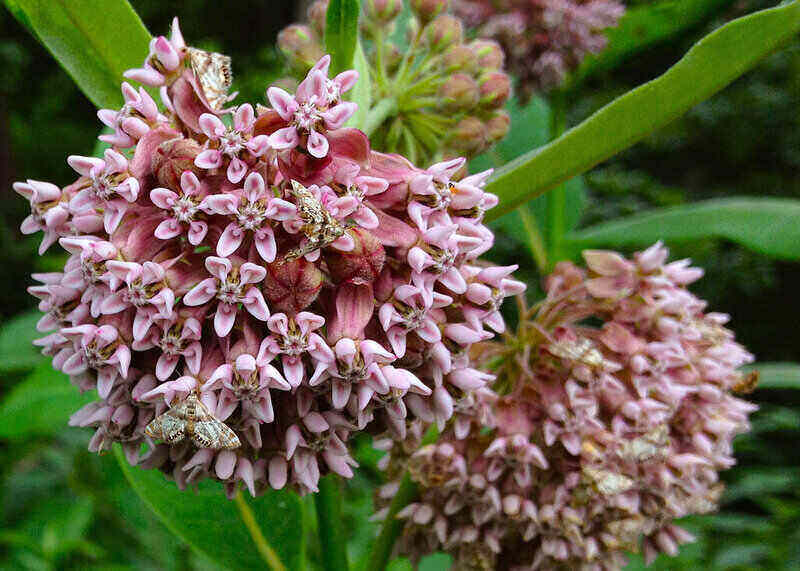
Photo Credit: Fritzflohrreynolds / Wikimedia Commons / CC BY-SA 3.0
Milkweed is a pollinator-friendly super-flower with over 100 varieties. Milkweed’s nectar not only attracts bees and butterflies but also natural garden predators like ladybugs and wasps, which act as organic pest control for your garden and will consequently mitigate the need for toxic pesticides.
Milkweed is also the go-to host plant for monarch butterfly larvae, which ingest its sap to keep predators at bay. Just make sure you wear gloves in the planting process to avoid skin irritation from the sap.
- USDA Hardiness Zones: 4A-9B
- Native to: Milkweed is native across most of the continental U.S.
- Milkweed varieties include: Common milkweed, swamp milkweed, California milkweed
- Care: Milkweed is a self-sufficient plant that won’t need much in the way of hands-on care. You can skip regular watering unless your area is prone to drought. Milkweed can be a skin irritant, though, so be cautious when handling it.
- Blooms: Tiny clusters of flowers, often white or pink; June-October
- Fragrance: Sweet, vanilla-scented
- Cost: Seed packets are available for free from the Live Monarch Educational Foundation and other butterfly conservation organizations.
2. Wild Bergamot (Monarda fistulosa)
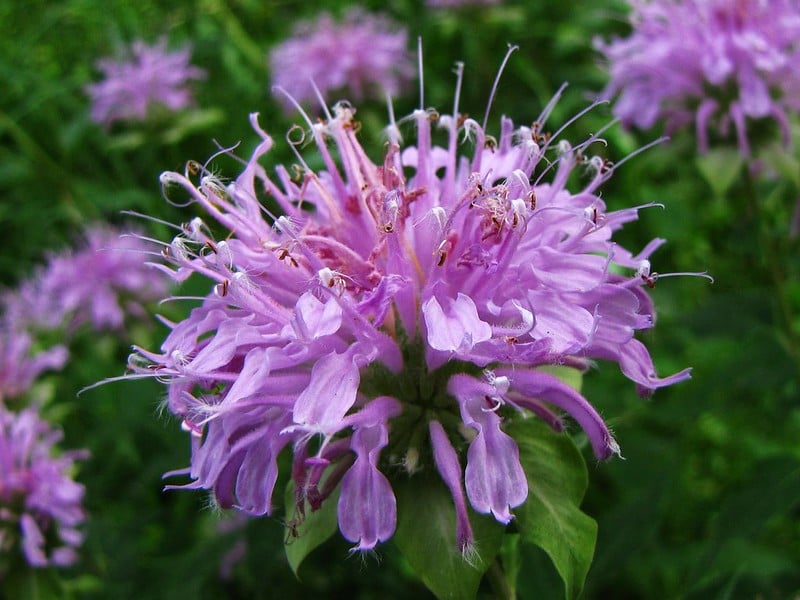
Photo Credit: U.S. Fish and Wildlife Service / Flickr / CC BY 2.0
Wild bergamot, also known as “bee balm,” is a bonafide bumblebee magnet. It thrives in a wide range of soils, including acid, lime, sand, and clay. Once wild bergamot has taken root, you can also harvest the leaves of this wildflower mint variety to make a soothing homegrown tea.
- USDA Hardiness Zones: 3-8
- Native to: Bee balm can be found in nearly all 50 states
- Wild bergamot varieties include: Claire Grace, Jacob Cline
- Care: Plants in the Monarda family are prone to powdery mildew, especially in areas with poor airflow, but Monarda fistulosa is generally resilient. Prune stems and ensure the soil doesn’t dry out, as bee balm likes moisture and can develop disease when stressed.
- Blooms: Tubular pink and lavender flowers with wispy petals; summer to late summer
- Fragrance: Citrusy flowers. Leaves will have a minty scent when rubbed together.
- Cost: Wild bergamot seed packets are available for around $6.
3. Snapdragons (Antirrhinum)
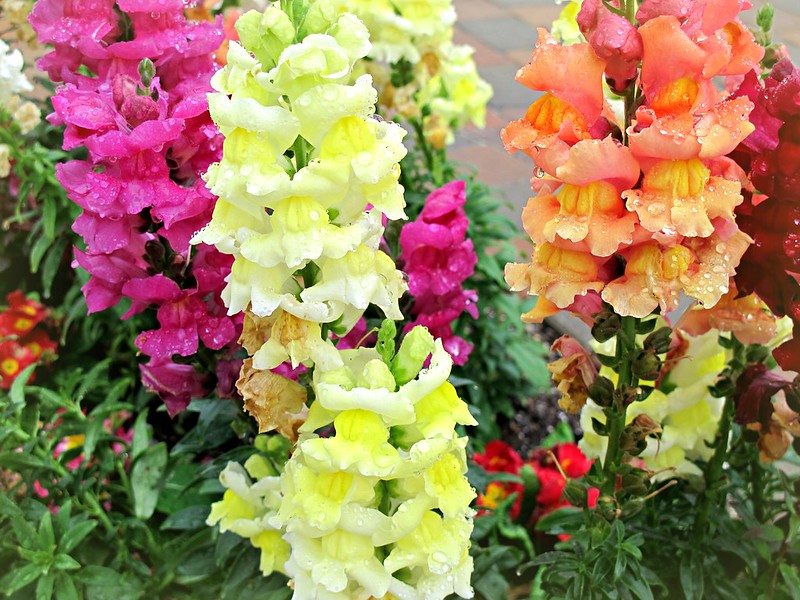
Photo Credit: Bennilover / Flickr / CC BY-ND 2.0
Snapdragons are one of the best plants for pollinator gardens. These perennial flowering plants hold their nectar inside of their petal “lips,” which naturally keep out unwanted critters and invite in bumblebees.
Other natural ways snapdragons entice bee populations: They release scent during bees’ most active hours, and have evolved their yellow, blue, and violet shades for maximum visibility. It’s a true show of colors for you and the bees, too.
- USDA Hardiness Zones: 7-11
- Native to: Snapdragons are found in the western United States.
- Snapdragon varieties include: Axion, Black Prince, Sonnet
- Care: Snapdragons prefer moist conditions in the first few weeks of garden acclimation. Tall varieties may require staking. Remove spent blooms as they appear, and clip the top stem and any side shoots to encourage more flowers.
- Blooms: Yellow, blue, purple, and pink flowers in a characteristic “dragon mouth” shape; blooms in autumn, spring, and into the summer in cooler climates.
- Fragrance: Light and fruity
- Cost: Snapdragon seed packets can be found for around $6.
4. Coneflower (Echinacea)
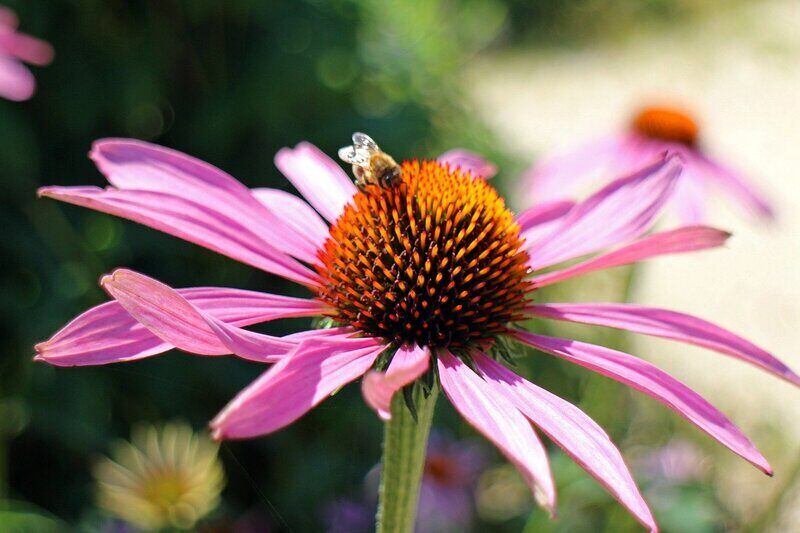
Photo Credit: Antranias / Pixabay
The scientific name for coneflowers — Echinacea — comes from the Latin word for “hedgehog” in reference to their prickly stems. Like goldenrods and daisies, these precious pink plants are members of the aster family and are known to attract butterflies and songbirds.
Looking for an at-home anxiety remedy or a way to boost your immunity ahead of cold and flu season? Some swear by echinacea’s health benefits for humans.
- USDA Hardiness Zones: 5-8, Magnus coneflowers will also thrive in Zone 3
- Native to: Coneflowers are native to eastern and central regions of the United States.
- Coneflower varieties include: Magnus, Pink Shimmer, Marry Me
- Care: Keep soil moist for best results if sowing from seeds. Avoid watering at night and getting water on the plant itself, as coneflower is prone to Alternaria leaf spot and botrytis.
- Blooms: Bright pink, red, and yellow flowers; typically July-September
- Fragrance: Coneflower’s scent varies based on pollination status and petal position. Initially earthy, the flower will start to smell of honey when the ray florets point downward to attract pollinators. After successful pollination, the flowers will emit a sweet, vanilla-like fragrance.
- Cost: Coneflower seed packets are available for around $6.
5. Cow Parsnip (Heracleum maximum)
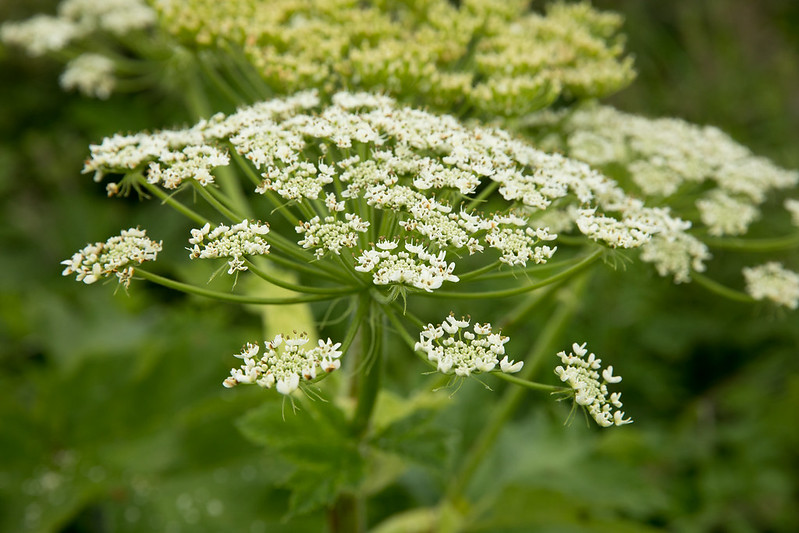
Photo Credit: U.S. Fish and Wildlife Service Midwest Region / Flickr / Public Domain
Cow parsnip is the only plant in its genus that’s native to the U.S., and it’s naturally found far and wide. The large gatherings of tiny flower clusters are characteristic of the carrot family and make this plant a native pollinator hotspot.
Cow parsnip is known to attract butterflies, native bees, and even beetles and moths to pollinate. Like milkweed, though, it can irritate human skin, so be sure to plant it safely.
- USDA Hardiness Zones: 3-9
- Native to: Cow parsnip is distributed from northern California to Georgia.
- Care: Cow parsnip will tolerate a variety of soils as long as it’s provided with enough moisture. Care is very easy for this hardy native plant, and cow parsnip is deer-resistant.
- Blooms: Clusters of small white flowers in flat-topped umbels, June-August
- Fragrance: Flowers smell sweet, similar to parsnip
- Cost: Cow parsnip seed packets start at around $10.
6. Butterfly Weed (Asclepias tuberosa)
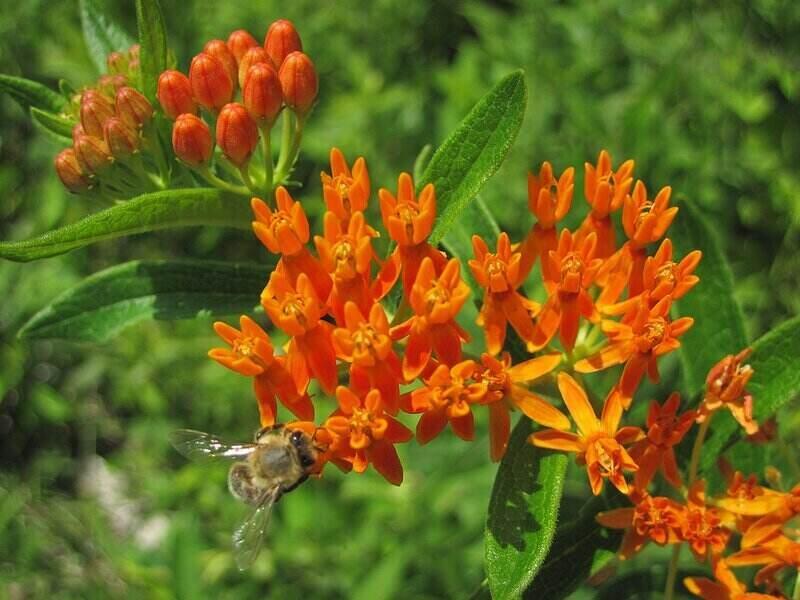
Photo Credit: James St. John / Wikimedia Commons / CC BY 2.0
Butterfly weed is prized for its bright orange blooms and its ability to attract butterflies, bees, and hummingbirds. This deciduous cousin of the milkweed can bloom into early fall and tolerates drought, making it a perfect addition to your other pollinator plants.
Fun fact: The fibers harvested from dried butterfly weed stems have been traditionally braided together to make rope, while the roots are used in tea as a cure for inflammation and infection.
- USDA Hardiness Zones: 3-9
- Native to: Butterfly weed is native across the country.
- Butterfly weed varieties include: Rolf’s milkweed, Canada root
- Care: Butterfly weed is easy to grow from seed. Keep soil moist until the plant is established, but afterward, it will require little water or fertilizer — the latter may even be detrimental to the plant. Its long, sturdy roots make transplanting difficult, so sow seeds in their permanent place among your other pollinator garden plants.
- Blooms: Tubular flower clusters in orange will bloom June-August and sometimes through September
- Fragrance: Sweet and mild, described as evoking vanilla or candy
- Cost: Butterfly weed seeds can be found for around $8.
7. Sunflower (Helianthus)
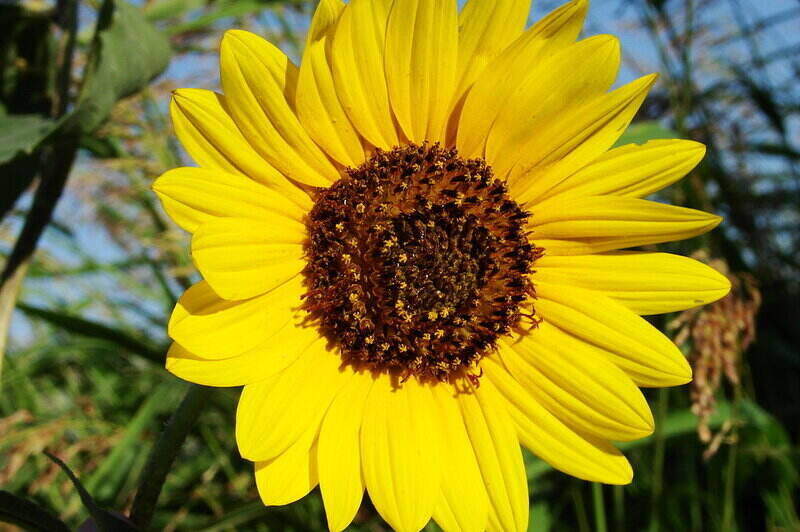
Photo Credit: Loadmaster / Wikimedia Commons / CC BY-SA 3.0
Love the bright blooms of sunflowers? These gorgeous annuals attract all kinds of butterfly and bee species. As a plus, sunflowers bloom throughout the fall, adding color to your autumn landscaping. That way, you can ensure your pollinator garden lasts for caterpillars during the pivotal cocoon-spinning season.
- USDA Hardiness Zones: 4-9
- Native to: Sunflowers are homegrown throughout the U.S.
- Sunflower varieties include: Soraya, American Giant, Russian Mammoth
- Care: Sunflowers do best with deep, regular watering before, during, and after flowering. Taller varieties with large, heavy flower heads will benefit from staking to prevent breakage and flopping.
- Blooms: Bright yellow flowers, July-October
- Fragrance: Mild, earthy
- Cost: Sunflower seed packets can be found for $5.
8. Blanketflower (Gaillardia aristata)
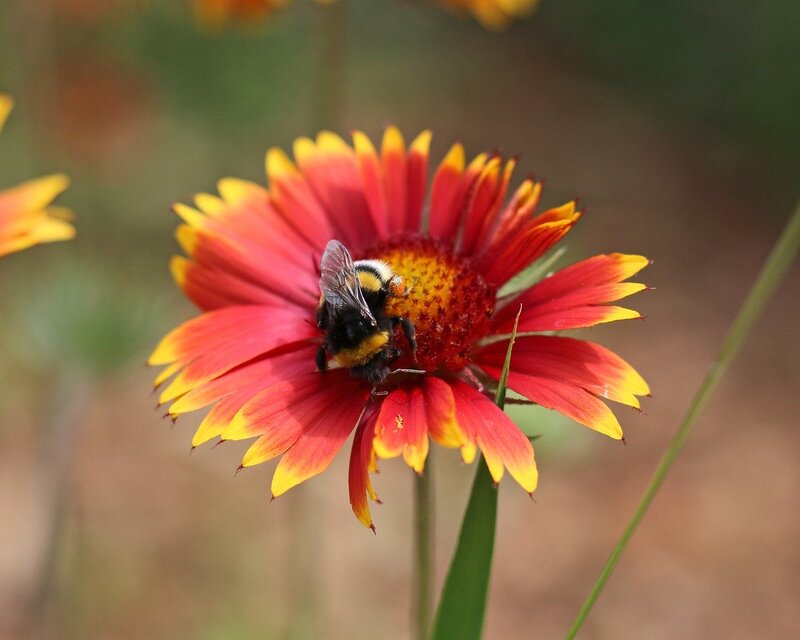
Photo Credit: PurpleOwl / Pixabay
Beautiful blanketflowers are a classic image of the American West. These ornamentals are a common choice for xeriscaping gardens due to their tolerance for rocky soils and low moisture, and they attract a wide variety of pollinator populations.
- USDA Hardiness Zones: 3-9
- Native to: Besides the American West, blanketflowers are also found around the Great Lakes and in certain parts of New England.
- Blanketflower varieties include: Goblin, Arizona Sun
- Care: Blanketflowers have few pest and disease problems and are drought tolerant. Remove faded flowers as they appear to encourage more blooms.
- Blooms: Wide, flat red and yellow flowers from early summer to early fall
- Fragrance: Sweet, candy-like scents ranging from licorice to bubblegum
- Cost: Blanketflower seed packets start around $5.
9. Black-Eyed Susan (Rudbeckia hirta)
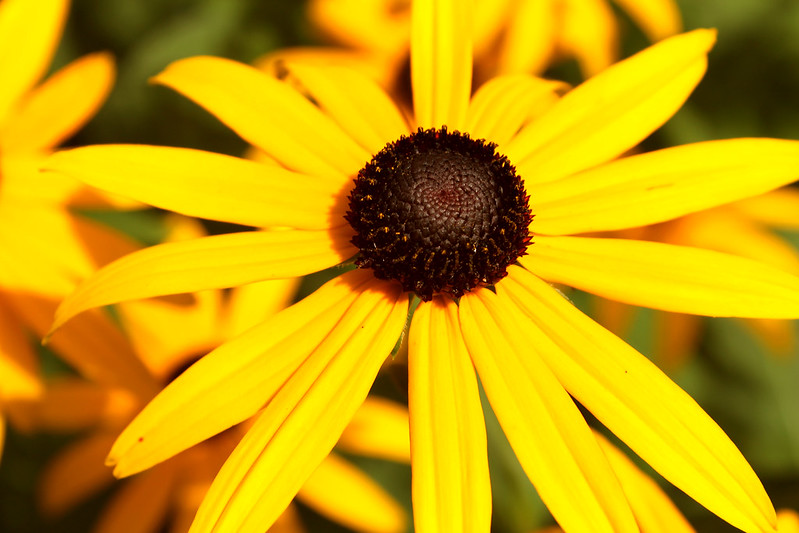
Photo Credit: Jack Pierce / Flickr / CC BY-SA 2.0
Sunny black-eyed Susans, like their blanketflower cousins, are both sweet on the eyes and pollinator magnets. Their bright yellow blooms draw nectar-loving bees and insects, while their seeds attract granivorous birds like sparrows and finches.
- USDA Hardiness Zones: 3-10
- Native to: Black-eyed Susans are native to most of the country.
- Black-eyed Susan varieties include: Denver Daisy, Goldsturm, Indian Summer
- Care: Black-eyed Susans can become aggressive if not given enough competition, so limit the spread by dividing clumps every four or five years. They prefer full sun and should be kept moist until fully grown, at which point you can gradually reduce watering.
- Blooms: Yellow, some varieties with a brown ring around the center; blooms from late spring through early fall
- Fragrance: Pleasant smell, similar to sweetgrass
- Cost: Black-eyed Susan seed packets are available for about $7 each.
10. Blazing Star (Liatris)
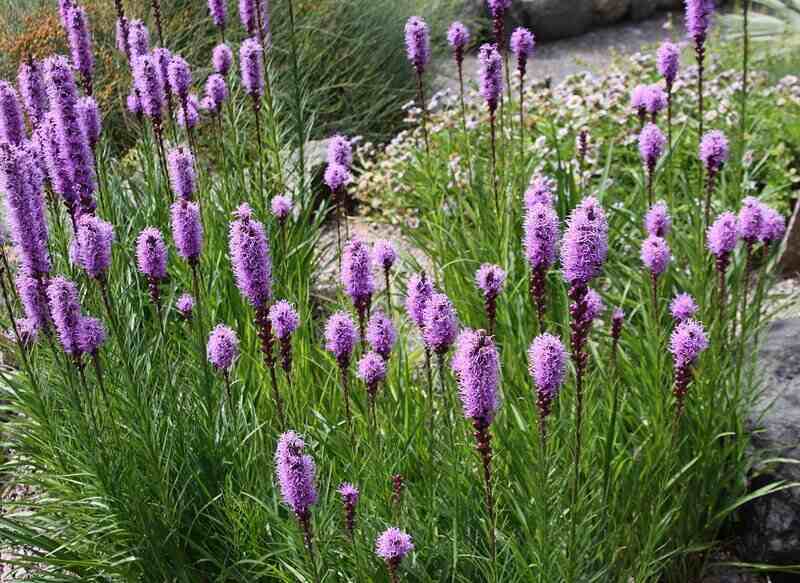
Photo Credit: Drew Avery / Wikimedia Commons / CC BY 2.0
The dense blazing star’s (Liatris spicata) unique flowers and sturdy stalks create a feathery appearance that has given rise to its alternate name, “the prairie gay feather.” These durable plants are drought and heat-resistant and easy to grow and propagate.
Blazing star’s purple and white blooms create a special appeal to avian pollinators, including hummingbirds and certain songbirds!
- USDA Hardiness Zones: 3-9
- Native to: Blazing stars are at home from north to south in the eastern U.S.
- Blazing star varieties include: Dotted Blazing Star, September Glory, Kobold
- Care: Blazing star prefers full sun and can thrive in almost all soil conditions, though quick drainage is essential as the roots are prone to root rot. An inch of water per week in the hottest months will prevent leaf scorch and flower stunting.
- Blooms: Purple and white stalks of flowers, July-August and some varieties into September
- Fragrance: No scent when blooming, but flowers will smell of vanilla when dried
- Cost: Blazing star seed packets are available for around $3.50.
FAQ About Native Plants
What are the Pros of Planting Native?
The main benefits of opting for native plants are their low-maintenance qualities: They are drought-tolerant, pest-free, and help control soil erosion.
Why are Native Plants Better for Pollinators?
Native plants are better for pollinators because they have abundant pollen and nectar with the right nutrients — a feast for beneficial insects. Native plants have evolved alongside the local wildlife, usually blooming just at the right time to support pollination, being essential to their life cycle.
Can you Plant Non-Native Plants in a Pollinator Garden?
Yes, you can include some non-native species in your pollinator garden to extend the season and provide pollinators with sustenance throughout the year. However, the best option for the local biodiversity is to stick to the native plants.
Sit Back and Watch the Show
If you create your pollinator garden with the native plants above, you can kick back, relax, and watch nature’s show. Snapdragons, sunflowers, and the rest will have hummingbirds, butterflies, and honeybees dropping by your yard more often than your mail carrier. As a bonus, you will have added splashes of color and whiffs of fragrance to your yard, too.
While we’ve spotlighted the best 10 native plants for your pollinator garden, there are scores of other candidates you might want to include. One way to get a pollinator garden as unique as you is to consult one of LawnStarter’s landscaping pros.
And if you’ve mastered your pollinator garden but your yard needs work, LawnStarter’s landscape pros can help with that, too.
Main Photo Credit: Johannes / Unsplash
